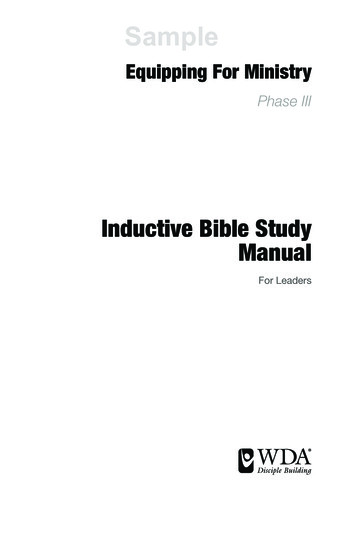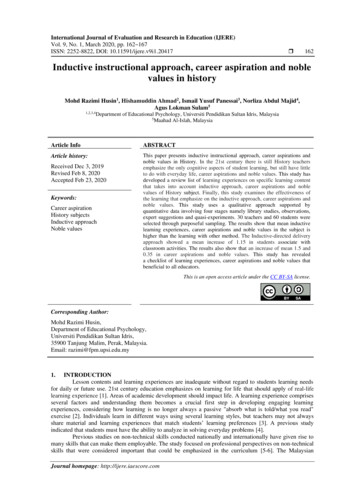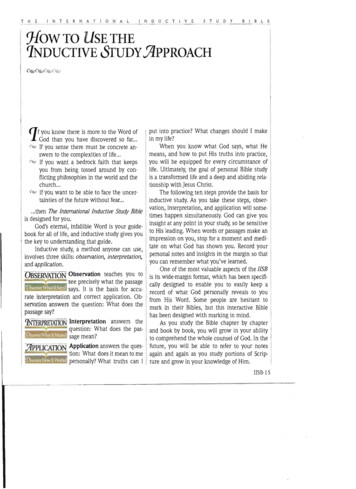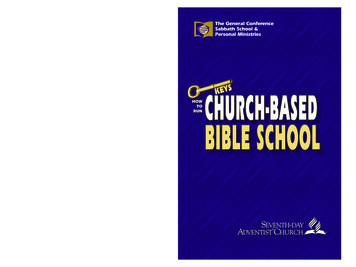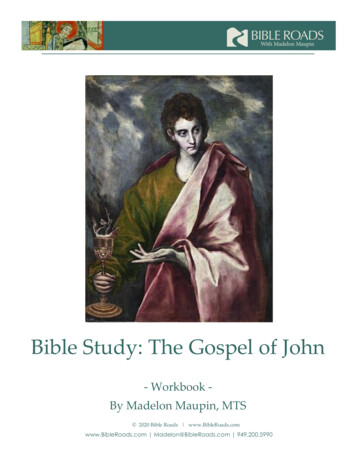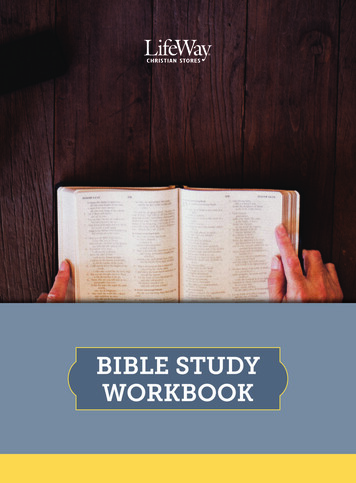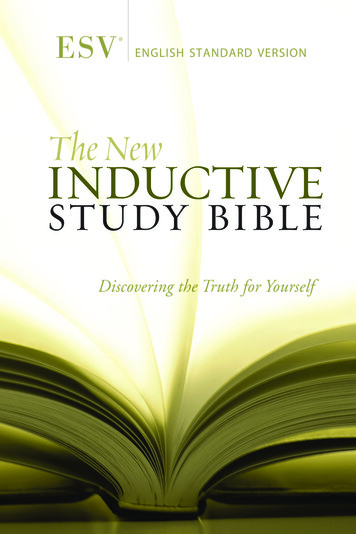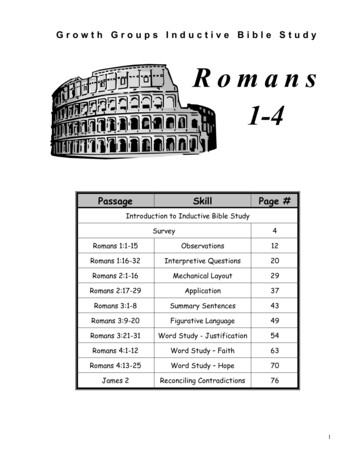
Transcription
Growth Groups Inductive Bible StudyRomans1-4PassageSkillPage #Introduction to Inductive Bible StudySurvey4Romans 1:1-15Observations12Romans 1:16-32Interpretive Questions20Romans 2:1-16Mechanical Layout29Romans 2:17-29Application37Romans 3:1-8Summary Sentences43Romans 3:9-20Figurative Language49Romans 3:21-31Word Study - Justification54Romans 4:1-12Word Study – Faith63Romans 4:13-25Word Study – Hope70James 2Reconciling Contradictions761
Have You Mastered the Book of Romans?(Romans Pre-test)Who wrote the book of Romans?From where did he write?Define “justification.”Can you quote Romans 3:23?Can you quote Romans 6:23?Define “sanctification.”What is the main topic of chapters 1-5?What is the main topic of chapters 6-8?In which chapter does Paul make the statement, “Wretched man that I am! Who will set me free from thebody of this death?”Which chapter explains the role of the Holy Spirit?2
IntroductionFor I am not ashamed of the gospel, for it is the power of God for salvation to everyone who believes,to the Jew first and also to the Greek. For in it the righteousness of God is revealed from faith tofaith; as it is written, “BUT THE RIGHTEOUS man SHALL LIVE BY FAITH.”Romans 1:16-17Over the next several weeks, we will study Romans in detail, committing portions of it tomemory, digging into the individual verses to determine what truths God desires to communicate, andapplying these truths to our everyday lives. These steps are part of a process called Inductive BibleStudy, where we seek to draw out the truths of scripture for ourselves and apply them to our lives. Itrequires the mastery of a set of skills to be used with great diligence (2 Tim. 2:15), persistence andtenacity by those whose hearts are pure before the Lord and filled by the Holy Spirit. It is the mosteffective method for learning biblical truth. Unlike more common methods of study which providethe student with a set of questions based on the text but limited by the writer’s own insight, in aninductive study you are limited only by the Holy Spirit (who does not yield the treasures of the Wordto the disobedient; Pr. 28:5; Mt. 6:22-23; John 7:17; 14:21) and by your own willingness to exert theeffort to dig deeper (Pr. 8:17). No one has yet discovered all the riches which are buried in the Wordwaiting to be uncovered (Col. 2:3). With inductive Bible study, every time you sit down to work withthe text there is a sense of anticipation - Perhaps today I will lay hold of some jewel of truth that hasnever been seen before.The process of inductive Bible study consists of three stages: Survey, Analysis and Synthesis.In the Survey stage we are looking for the overall structure and message of the book and how it fitswith the rest of biblical literature. In the Analysis stage we concentrate our efforts on Observation(what is written in, or omitted from, the text), Interpretation (the meaning of what we have observedin its original context), and Application (the significance of that meaning to us personally in ourmodern day context). In the Synthesis stage we are trying to answer the question, “How do the detailsthat were uncovered in the analysis stage fit together?” “Do I understand the flow of thought, and wasmy original understanding of the theme correct, or does it need revision?”The price for first hand knowledge of the Word of God is obviously quite high. You mustinvest great quantities of time, mental energy and spiritual sensitivity in order to truly know andproperly apply God’s truths. Is it worth the price? King David certainly believed that it was:“The law of your mouth is better to me than thousands of gold and silver pieces O how Ilove Your law! It is my meditation all the day How sweet are Your words to my taste!Yes, sweeter than honey to my mouth! . Your word is a lamp to my feet and a light to mypath.” (Psalm 119:72, 97,10,105)So did the apostle Paul:“More than that, I count all things to be loss in view of the surpassing value of knowingChrist Jesus my Lord, for whom I have suffered the loss of all things, and count them butrubbish so that I may gain Christ” (Philippians 3:8)Do you believe their testimony? Will you devote the time and effort required to know and followChrist through His word like these men did? Will you dive deep into Romans this semester in orderto know God more fully?3
Survey1) Pray and ask the Holy Spirit to illuminate your study2) Skill of the Week – SurveyMany film directors create their opening scenes by flying the audience over a large, impressivetract of city or country, while the title sequence plays. Gradually, they zoom in on one building thatwill serve as a focal point for the movie. Why not simply start the movie at this house or building?By opening the film with an extensive fly-over, the director gives his audience a sense of the biggerpicture where his story will occur. The audience now has some idea of the film’s time period, scope,and geographical location – characteristics that make up the context of the movie.Like this film director, we too need to start our study of Romans by looking at the overallcontext of this book. In biblical terms, we need to have a grasp of the overall flow of revelation, OldTestament and New. We also need to understand where our particular book fits in that flow, and thegeographical, historical, political, and spiritual background of both the writer and the recipients. AsHoward Hendricks is fond of saying, “The three most important tools for interpretation are context,context and context.”3) Complete the following steps as you survey Romans:A. Read through the entire book of Romans. As you are reading, jot down anyobservations you discover about the following characteristics: Relationships between ion of material devoted to an idea, person or event (e.g. crucifixion events)oStated purpose (John 20:30; Prov. 1:2-6)oOrder (Gen. 1-3; Luke 4)4
RepetitionoTerms, phrases, clauses (Ps. 136:1-2)oCharacters (e.g. Barnabas in Acts)oEvents/circumstances (Judges)oPatterns (e.g. Adam and Christ in Romans)oCitation of OT passages in NT (Mt. 12:39-41; 1 Peter/Psalm 34)Atmosphereo For example sarcasm, compassion, danger, intrigue, urgency, despair, humility, awe, gratitude, joy,tenderness, zeal, anger, concern, cautionLiterary StructureoBiographical - story built around key personsoGeographical - return to key places in Genesis and movement in ExodusoHistorical - story built around key events; e.g. Joshua, John (7 “signs”)oChronological - often employed in biography and history but not always (Judges)oIdeological - each idea builds on the preceding to support the controlling themeB. Read the following background articles on the book, author, recipients and thecity or region of the recipients. Such articles can be found in a Bible dictionary,Bible encyclopedia or at the beginning of a commentary. Some study Bibles will alsocontain good, concise background articles before each book.Article on the Book of RomansThis letter is the premier example of the epistolary form of writing, not only in the Pauline body of materialand in the New Testament but also in all of ancient literature. It stands first in every list of the Apostle Paul’swritings though it was not first in time of composition. This bears witness to the importance of the work bothin its theme and in its content. It may also reflect the significance of the location of the letter’s first readers,the imperial capital of Rome. In addition a possible tie grows out of the fact that the Book of Acts ends withPaul in Rome so that his letter to the Romans follows naturally in the order of Bible books.Authorship. That Paul is the author of this letter is denied by almost no one. Even the ancientheretics admitted Romans was written by Paul. So do the modern (19th century and later) radicalGerman critics, who deny many other facts in the Scriptures.Recipients. A valid question does exist concerning the identity of the recipients of this letter. Paulsimply addressed it “to all in Rome who are loved by God and called to be saints” (Rom. 1:7); he did5
not address it to “the church in Rome.” That a church did exist in Rome is obvious, because Paul sentgreetings to the church that met in the home of Aquila and Priscilla (16:5). Probably several churcheswere in Rome; perhaps this multiplicity of churches is why Paul addressed the letter to “the saints”instead of to “the church.”Were these believers in Rome Jews or Gentiles in ethnic background? The answer is both. Aquila, forexample, was a Jew (Acts 18:2), as were Andronicus, Junias, and Herodion, all three identified as Paul’srelatives (Rom. 16:7, 11). According to Josephus and others a large Jewish colony lived in Rome (cf. Acts28:17-28). But Rome was a Gentile city, the capital of a Gentile empire in which all Jews, believing andunbelieving, formed a small minority. In addition, though Paul never failed to witness and to minister toJews, his calling from God was to be “the apostle to the Gentiles” (Rom. 11:13; cf. 15:16). So it is reasonableto conclude that his readers were mostly Gentile in background.Since the Apostle Paul had not yet visited Rome, how had the Christian faith been introduced to the city?Apparently no other apostle had yet reached Rome, in the light of Paul’s stated purpose to be a pioneermissionary and to open virgin territory to the gospel (15:20). In particular, it is evident that Peter was not inRome at that time because Paul expressed no greetings to him, a grievous error if Peter indeed were there.Perhaps a partial answer to the founding of the church at Rome is the fact that “visitors from Rome”(Acts 2:10) were in the crowd that witnessed the miracle of Pentecost and heard Peter’s sermon. Some ofthem probably were among the 3,000 converts that day and returned to Rome as believers in Jesus Christ topropagate their faith. Other believers migrated to Rome through the years since Pentecost, for Rome was amagnet that drew people from all over the empire for business and other reasons.Place and Date. Though Paul never named the city, it is obvious that he wrote this letter fromCorinth, Cenchrea (16:1) being its eastern harbor. The letter was written at the close of Paul’s thirdmissionary journey during the “three months” he was in Greece (Acts 20:3) just before his return toJerusalem with the offering from the churches of Macedonia and Achaia for the poor believers there(Rom. 15:26). After leaving Corinth, Paul was in Philippi during the Passover and the Feast ofUnleavened Bread (Acts 20:6) and desired to reach Jerusalem by Pentecost (Acts 20:16). The letterwas written, therefore, in the late winter or early spring of A.D. 57 or 58.Purposes. While Phoebe’s projected trip to Rome (Rom. 16:2) was undoubtedly the specificoccasion for Paul’s writing this letter, he had several objectives in writing. The most obvious was toannounce his plans to visit Rome after his return to Jerusalem (15:24, 28-29; cf. Acts 19:21) and toprepare the Christian community there for his coming. The believers in Rome had been on Paul’sheart and prayer list for a long time (Rom. 1:9-10) and his desire to visit them and to minister tothem, unfulfilled to this point, was finally about to be satisfied (1:11-15; 15:22-23, 29, 32). ThereforePaul wanted to inform them of his plans and to have them anticipate and pray for their fulfillment(15:30-32).A second purpose Paul had for writing this letter was to present a complete and detailed statement of thegospel message he proclaimed. Paul was eager “to preach the gospel also to you who are at Rome” (1:15)and he wanted them to know what it was.A third purpose for writing this letter is not as obvious as the first two. It is related to the tension betweenthe Jewish and the Gentile segments in the Christian community at Rome and a possible conflict betweenthem. Paul did not take sides, but he carefully set forth both sides of the question. On the one hand heemphasized the historical and chronological priority of the Jews—“first for the Jew, then for the Gentile”(Rom. 1:16; cf. 2:9-10). He also stressed the “advantage . . . in being a Jew” (3:1-2; 9:4-5). On the other handhe pointed out that “since there is only one God” (3:30), He is the God of the Gentiles as well as the God ofthe Jews (3:29). As a result “Jews and Gentiles alike are all under sin” (3:9) and alike are saved by faith inthe Lord Jesus Christ and His redemptive and propitiatory sacrifice. Furthermore, in order to bring believingGentiles into His program of salvation, extending His grace to all human beings, God temporarily halted Hisspecific program for Israel as a chosen nation, since that nation through its official leaders and as a whole hadrejected in unbelief God’s Son as the Messiah. During this period God continues to have a believing“remnant chosen by grace” (11:5) “until the full number of the Gentiles has come in” (11:25) and God takesup again and fulfills His promises to Israel as a nation.6
Related to the Jewish-Gentile tension that runs throughout this letter is a muted but definite undertonethat questions God’s goodness and wisdom and justice as seen in His plan of salvation. No complaintsagainst God are voiced, but they are implied. As a result this letter to the Romans is more than an expositionof Paul’s “gospel of God’s grace” (Acts 20:24), a declaration of God’s plan of salvation for all human beingsby grace through faith. It is a theodicy, an apologetic for God, a defense and vindication of God’s nature andHis plan for saving people.(From The Bible Knowledge Commentary by John A. Witmer. Published by Scripture PressPublications in 1985.)Article on RomeRoman Empire, the lands around the Mediterranean Sea and in Europe ruled by Rome. While eventsrecorded in the books of the OT took place prior to the emergence of Rome as the sole power in theMediterranean basin, Rome’s influence was already strong at the time of the Maccabean revolt (begun 167B.C.), and from that point until Rome assumed control over Palestine in 63 B.C. its power influenced eventsthroughout the eastern Mediterranean world.The Romans saw themselves as the legitimate rulers of the civilized world. This vast empire had beengained, Cicero wrote, only through just wars: ’Our people by defensive wars in support of its allies havetaken possession of the whole world’ (De Re Publica 3.35). After the aristocratic misrule in the provincesand the bloody civil wars at home, the imperial order seemed to usher in a new age of peace. It providedpermanent military security and high standards of administrative, judicial, and fiscal efficiency. The new eraof peace was widely proclaimed in Augustan literature. Augustus’ return from campaigns in Gaul and Spainwas celebrated by dedication of the Ara Pacis Augustae (altar of the peace of Augustus), in January, 9 B.C.Augustus had had the doors of the temple of Janus closed in 29 B.C., signifying the end of warfare. Imperialcoinage also celebrated the new age of peace. Even for many of the subject peoples the new Roman orderpresented an effective and stable rule that stood above local and regional disputes.The Birth of Christianity: It was in the time of Augustus that Jesus was born (Luke 2:1), and that the eventsrecorded in the NT began. Rome was thus the dominant political and military force of the world of the NT.According to the Gospel records, Jesus was born in Bethlehem as the result of a Roman census (Luke 2:1-4),drew illustrations in his teaching from the ever present occupying forces (Matt. 5:41, a service a Romansoldier could demand of a civilian), lived his life in a land under Roman domination, and was put to death bya Roman governor on a Roman means of execution, the cross.Paul carried out his entire mission within the bounds of the eastern portion of the Roman Empire, wrotehis most carefully reasoned letter to Christians who lived in its capital, took advantage of his Romancitizenship (Acts 16:37-38), was arrested by Romans in Jerusalem (Acts 21:31-33), escorted by them (23:24)to the Roman governor’s residence in Caesarea (23:33), and when he exercised the citizen’s right to appeal toCaesar (25:11) they took him to Rome itself (Acts 27-28).The apostle Peter is remembered to have written a letter sent to Christians in the Roman provinces inAsia Minor (1 Pet. 1:1), and tradition has it that he was martyred in Rome, the capital city of the empire. Intrying times, the author of the Revelation of John denounced bitter persecutions of Christians (Rev. 17),persecutions that came to an official end only when the emperor Constantine in A.D. 313 issued his edict oftoleration and subsequently gave his official favor to Christianity as his own religion. Thus the entire careerof the early church, as well as the events recorded in the NT and the writing of the NT books themselves, tookplace in a world dominated by the Roman EmpireLife in Rome: The Romans also prided themselves on more utilitarian building accomplishments such aspaving roads, constructing systems of bridges for them, and especially using aqueducts to deliver runningwater to the city. The availability of water encouraged the construction of fountains and numerous publicbaths. Augustus’ friend Agrippa restored and enlarged four existing aqueducts. He was also able to use7
concrete to build two more. Agrippa was the first to have several water channels run over a single series ofstones. Another element in his overhaul of the city’s drainage system was repairing the retaining walls alongthe Tiber River.The public baths were just as much centers of social life as the forum, the Circus Maximus, or theamphitheaters. The largest bath remains are those of Caracalla (A.D. 211-217) and Diocletian (A.D. 289-305).They cover some 30 acres and consist of a conglomeration of rooms and courtyards. Baths of all types wereavailable: cold, warm, hot, steam, air, and sun. There were facilities for exercise, gymnastics, and massage.In addition the garden parks, the library, and the museum provided places for conversation and study. Theadmission fee and the cost of oil for anointing the body may have kept many from using these baths toooften. The city also boasted numerous smaller baths. There were some hundred and seventy such underAugustus and the number swells to over nine hundred in late antiquity (fourth century A.D.).The wealthier Romans lived in villas, an atrium style of house with a peristyle section and a garden areain the back around which one found the dining room and bedrooms. Lead pipes were used to connectindividual homes to the sewage and water systems. Heaters created warm air under the floors of the houses.The slaves occupied the second floor. The emperor Augustus still lived in a modest home on the Palatine, butTiberius built the first palace and Nero the famous ’Golden House.’ Later centuries would see the wealthyalso building palaces as homes.Most of the approximately one million inhabitants of the city, however, were crowded into the brick andwooden tenements, insulae (Lat., ’islands’), which are well known from excavations at Ostia. Such buildingscould be as large as 4,000 square feet and rise five to six stories. They had no water supply or latrines. Theground floors contained shops, workshops, and storerooms. A typical ground-floor unit contained three tofive rooms. As one went higher in the building the units became smaller and darker. The insulae werecrowded, noisy, and very public. Not surprisingly many shopkeepers moved out onto the streets to conducttheir business, thereby contributing to the general congestion. Vehicular traffic along the Appian Way wasbanned during the day. Consequently the uproar of carts along its stones made for an equally noisy night.These tenement buildings were also perpetual fire traps and burned rapidly in the great fire under Nero inA.D. 64, which was blamed on the Christians.(Achtemier, Paul J., Th.D., Harper’s Bible Dictionary, (San Francisco: Harper and Row, Publishers, Inc.)1985.Background Map8
Chronology of the Life of PaulDateEventSummer 35Paul’s conversion (Acts 9:1-7)Summer 35-37Damascus and Arabia (Acts 9:8-25; Gal. 1:16-17)Summer 37Jerusalem, first visit (Acts 9:26-29; Gal. 1:18-20)Autumn 37Tarsus, Syria-Cilicia (Acts 9:30; Gal. 1:21)Spring 43Traveled to Antioch (Acts 11:25-26)Autumn 47Relief visit to Jerusalem (Acts 11:30; Gal. 2:1-10)Autumn 47Spring 48In Antioch (Acts 12:25-13:1)April 48Sept. 49First missionary journey (Acts 13-14)Autumn 49Jerusalem Council, third visit (Acts 15)Winter 49/50In Antioch (Acts 12:25-13:1)April 50-Sept. 52 Second missionary journey (Acts 15:36-18:22)Winter 52/53In AntiochSpring 53May 57Third missionary journey (Acts 18:23-21:16)May 57Meeting with James (Acts 21:13-23)Letters WrittenGalatians (written in Antioch;Autumn 49)1&2 Thessalonians (Summer 51)1&2 Corinthians (Spring 56;Fall 56) Romans (Winter 56/57)May 57-Aug. 59 Arrest, trial and imprisonment (Acts 21:26-26)Aug. 59-Feb. 60 Voyage to Rome (Acts 27:1-28:29)Feb. 60March 62First Roman imprisonment (Acts 28:30)Autumn 62Eph. (Autumn 60);Col. & Philemon (Autumn 61)Philippians (Spring 62)1 TimothySpring 63Autumn 67Asia Minor, Spain, Crete, Asia Minor,Nicopolis, Macedonia, GreeceTitus (Summer 66)Autumn 67Arrested and brought to Rome2 Timothy (Autumn 67)Spring 68Paul’s deathSept. 2, 70Destruction of Jerusalem9
C. Complete this “Survey Worksheet” from your initial reading of Romans and thebackground articlesRomans 1-4 SurveyTheme (What is the controlling idea that holds all the parts together?):Purpose(s) (Why was this book written?):Date:Author (including characteristics and history):Setting/Place of Writing (What do we know about the author’s situation as he wrote? What dowe know about other historical events happening at the time of writing?):Audience (What do we know about the recipients, their city, their history, culture, etc.?):Repeated Themes:Key Verses:10
D. Read Romans 1-4 again and create titles for the following paragraphsTips:1. The first title and several section titles are included as examples. Feel free to change them.2. Each paragraph title should be 1-4 words.3. If you don’t agree with the paragraph divisions given below, change them. However, youshould have a reason for changing them.4. Finally, don’t copy the paragraph titles straight from your Bible. Your titles shouldrepresent your understanding of each paragraph.Romans 1-4 Survey1:1-17Introduction of author, audience and theme1:1-71:8-151:16-17Righteousness by -124:13-174:18-25E. Memorize Romans 1:16-1711
Romans 1:1-151) Pray and ask the Holy Spirit to illuminate your study2) Read Romans 1-4 again this week3) Memorize: Romans 1:14-154) Skill of the Week – ObservationsObservation is the most important element in inductive Bible study. It is like the foundation ofa house. When the foundation is well-laid, the house can be constructed with confidence. Likewise,if we observe thoroughly, our next step, interpretation, will follow naturally and accurately. Our wisepredecessor Solomon has instructed us, “It is the glory of God to conceal a matter, but the glory ofkings is to search out a matter.” (Proverbs 25:2) The treasures of God’s wisdom await our discovery a discovery which comes only through diligent, active searching.“[I pray] that the God of our Lord Jesus Christ, the Father of glory, may give to you a spirit of wisdomand of revelation in the knowledge of Him. I pray that the eyes of your heart may be enlightened, sothat you may know what is the hope of His calling, what are the riches of the glory of His inheritancein the saints, and what is the surpassing greatness of His power toward us who believe.” (Ephesians1:17-19)Here are some general guidelines to keep in mind before you begin your observations. First,our time for study of His Word must be given a place of priority. We must devote to it the time ofday we are most alert, rather than relegating it to the position of well-intentioned afterthought.Second, we must learn to see again. We must stretch our minds as if we were pursuing the mostimportant prize in the world because, in fact, we are. Don’t overlook anything. Record everything.Nothing is too trivial to be observed. It is the trivial observation which often spurs the mind toapprehend deeper truth. Third, it is God’s desire to reveal Himself to you, not to hide Himself.Approach the Word expectantly, dependently and obediently. God is able and willing to disclose toyou the profound mysteries of His Word, but He is not in the habit of revealing His will to thecurious. Remember, as our Lord Himself explained, “He who has My commandments and keepsthem, he it is who loves Me; and he who loves Me shall be loved by My Father, and I will love him,and will disclose Myself to him.” (John 14:21) Now let’s go over the basic techniques for makinggreat observations.What should you look for within a passage?A. The Basic Questions:o Who – Who is performing or receiving the action of the sentence or paragraph?o What – What is occurring?o When – When is it occurring? Is there a sequence of events?o Where – Where is the action occurring? Does the location change within the paragraph?o Why – What is the goal or purpose for the action? Who benefits? What is his/her motivation?o How – What is the means or manner for accomplishing the action?12
B. Key Words (especially theologically important terms)C. Important Connectives - Indicate the relationships within and between clauses and paragraphso Temporal - after, then, as, until, before, when, now, whileo Local or geographical - whereo Logical – read next two pages entitled “Structural Indicators”o Emphatic - indeed, onlyD. Grammatical Construction - How does each word function in the sentence?o Verb - creates the “action” or state of being Note the tense of the verb (when is the action being performed) Note the “voice” of the verb (active - the subject is doing the acting; passive - the subject is beingacted upon)o Noun - name of a person, place, thing or qualityo Pronoun - used in the place of a nouno Adjective - modifies or describes a nouno Adverb - modifies a verb, adjective or other adverbE. Figures of speech - Non-literal language (e.g. “I am the bread of life”)F. Context of the preceding and following passageo How is this passage related to the previous and following passages?o What connecting words are used between the passages?o Does the audience, mood, or subject change between the passages?G. Things that are missing – what is not included in a passage can be just as important as what is!o What words, phrases, or ideas does the author not include that you would have expected?H. Differences between translationso Use more than one translation of the bible while you record observations. This will help you get abetter grasp on the author’s intended meaning and can be a great source of additional observations. Irecommend using any combination of NASB, NKJV, NIV or KJV.Example: Observations for Romans 1:1-2v 1:(a) Paul begins his letter by introducing himself(b) All of Paul’s descriptions of himself concern his role or mission for Christ(c) Paul gives 3 descriptive attributes of himself(d) Paul’s first description is servanthood, not apostleship as in other letters(e) Paul is a servant of Christ Jesus(f) Paul’s calling is as an apostle(g) The purpose for which Paul was set apart is specifically for the gospel(h) The gospel is “of God” whereas Paul is a servant “of Christ”v 2:(a) “Which” refers to the “gospel of God”(b) God promised (“promised” is in the past tense) the gospel before it was actually delivered(c) The promise was given by God (presumably the Father); no mention of Son or Spirit(d) The promise was delivered through men (men were the conduits or agents) who held the title oroffice of “prophet”(e) The prophets are “His” (sent from God, accountable to God)(f) There were multiple prophets who recorded various aspects of the gospel; not just one prophet(g) The promise was recorded in the scriptures, which are holy(h) The specifics of the promise were apparently not revealed in nature or in any other written source13
Structural IndicatorsStructural indicators are techniques an author can use to develop his argument within a paragraph andthroughout a book. Noticing these will help you to understand the flow of thought and to build an outline ofthe book.Comparison: points out the similarities between two or more related ideas, or simply joining like ideas(association). Observe Hebrews 5:1-10 for a comparison of the priesthoods of Aaron and Christ.“But his delight is in the law of the LORD, and (association) in His law he meditates day and night. And hewill be like (comparison) a tree firmly planted by streams of water, which yields its fruit in its season, and itsleaf does not wither; and in whatever he does, he prospers.” (Ps.1:2-3)Contrast: points out dissimilarities between thoughts or ideas. This indicator is often easily identified by theuse of the word “but.” An excellent example is the comparisons and contrasts Paul makes between Adam andChrist in Romans 5:12-21. See also Ps. 73.“Now the deeds of the flesh are evident But the fruit of the Spirit is .” (Galatians 5:19-23)Purpose: indicates why the author made a particular statement. This can take the form of advice, admonition,warning, or promise, etc. and is frequently indicated by the phrase “in order that.”“ but these have been written that you may believe that Jesus is the Christ, the Son of God; and that believingyou may have life in His name. (John 20:31)And behold, there was a man with a withered hand. And they questioned Him, saying, "Is it lawful to heal onthe Sabbath?"-- in order that they might accuse Him. (Matt 12:10)Result: indicates the consequences of an idea(s), ac
city or region of the recipients. Such articles can be found in a Bible dictionary, Bible encyclopedia or at the beginning of a commentary. Some study Bibles will also contain good, concise background articles before each book. This letter is the premier example of the epistolary
